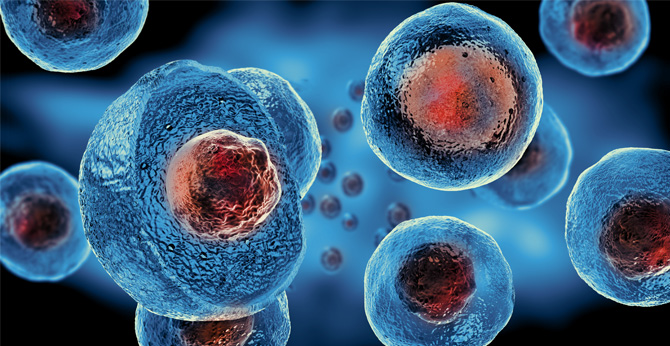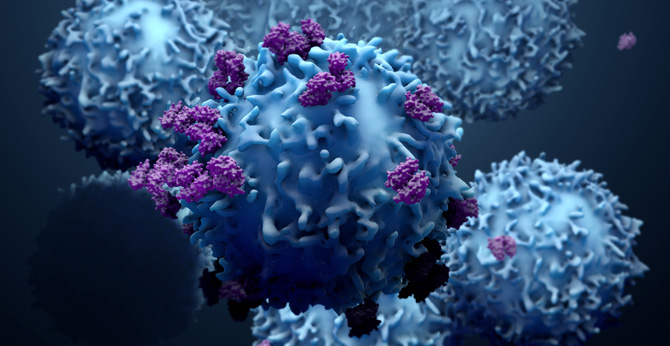All products and services are For Research Use Only and CANNOT be used in the treatment or diagnosis of disease.
Our CD229 CAR-T products and services are aimed at helping researchers and biopharmaceutical companies accelerate their development of innovative cancer immunotherapies. Please find our product offering available below.
Cluster of differentiation 229 (CD229), also known as the lymphocyte cell-surface molecule Ly-9 or SLAMF3, is type I transmembrane glycoproteins. CD229 belongs to the signaling lymphocytic activation molecule family (SLAMF) of immune receptors, which play a crucial role in immune cell activation and development. CD229 is primarily found on the surface of lymphocytes, particularly T and B cells. It acts as a cell adhesion molecule, allowing cells to interact and adhere to each other during immune responses. It is also involved in the development and function of immune cells, including the regulation of T-cell activation and tolerance. Abnormal expression or dysregulation of CD229 has been associated with certain diseases and conditions, including cancer and autoimmune disorders. It has been suggested that CD229 may serve as a potential therapeutic target or prognostic marker in cancers such as acute lymphoblastic leukemia (ALL), chronic lymphocytic leukemia (CLL), and B-cell non-Hodgkin lymphomas.
Associated Disease
Creative Biolabs provides the one-stop solution to meet all your CD229 CAR-T research needs. Our team design and optimize CAR constructs tailored to your specific research requirements. Our scientists are experienced in CAR-T in vitro and in vivo studies from optimal design to execution. In addition, our dedicated technical support team is available to assist with any questions or concerns you may have during the development of your CAR-T therapy research.
Creative Biolabs offers a comprehensive assessment service to test the level of CD229 CAR. For example, flow cytometry is a widely used method to analyze CAR expression on the surface of cells.

Fig.1 Surface expression of CD229-CAR as evaluated by flow cytometry.1
In vitro CAR-T cell proliferation involves culturing and stimulating CAR-T cells with specific growth factors or antigens to promote their expansion. Our experts provide several tests to evaluate the proliferation capacity of CAR-T cells in vitro and monitor their growth over time, providing valuable insights into their therapeutic potential.

Fig.2 Determination of CD229-CAR proliferation using flow cytometry.1
Creative Biolabs provides cytokine release test services using various technologies that allow for the determination of the level of a single cytokine or the simultaneous measurement of multiple cytokines in a single sample.

Fig.3 The cytokine levels in the supernatant when anti-CD229 CAR-T cells co-cultured with CD229-positive U-266 cell line.1
Cytotoxicity assays can provide valuable information for the effectiveness of CAR-T cells and for determining the appropriate CAR-T cell dosage for clinical applications. We perform several cytotoxicity assays to assess the effectiveness of anti-CD229 CAR-T cells in killing cancer cells.

Fig.4 The cytotoxicity of anti-CD229 CAR-T cells against tumor cells.1
Our comprehensive services include the evaluation of the anti-tumor efficacy of CD229 CAR-T therapies in mice models. We have a team of experienced researchers who can assist you in designing and conducting the experiments. We can work with both subcutaneous and orthotopic tumor models depending on your specific requirements. The tumor growth and regression are monitored over time to evaluate the efficacy of CAR-T therapy.

Fig.5 Anti-tumor activity of anti-CD229 CAR-T cells in vivo.1
Reference
 Loading...
Loading...
| CAT | Product Name | Target Species | Antibody Clone | Antibody Host | Receptor Construction | Vector Type | Targeting Cell Type | CAR Vector Type | Inquiry & Datasheet |
| CAR-0320ZP1 | Anti-CD229 (SI406DS) h(CD28-CD3ζ) CAR, pCDCAR1 | Mouse | SI406DS | Rabbit | scFv-CD28-CD3ζ | Lentiviral vector | T Cell | ||
| CAR-0320ZP2 | Anti-CD229 (SI406DS) h(4-1BB-CD3ζ) CAR, pCDCAR1 | Mouse | SI406DS | Rabbit | scFv-4-1BB-CD3ζ | Lentiviral vector | T Cell | ||
| CAR-0320ZP3 | Anti-CD229 (SI405DS) h(CD28-CD3ζ) CAR, pCDCAR1 | Mouse | SI405DS | Rabbit | scFv-CD28-CD3ζ | Lentiviral vector | T Cell | ||
| CAR-0320ZP4 | Anti-CD229 (SI405DS) h(4-1BB-CD3ζ) CAR, pCDCAR1 | Mouse | SI405DS | Rabbit | scFv-4-1BB-CD3ζ | Lentiviral vector | T Cell | ||
| CAR-0320ZP5 | Anti-CD229 (SI404DS) h(CD28-CD3ζ) CAR, pCDCAR1 | Mouse | SI404DS | Rabbit | scFv-CD28-CD3ζ | Lentiviral vector | T Cell | ||
| XS-0822-YF627 | Anti-Human CD229 (XW-627) h(41BB-CD3ζ) CAR IVT Plasmid, pCARIVT | Human | XW-627 | Mouse | scFv-41BB-CD3ζ | In Vitro Transcription (IVT) Vector | |||
| XS-0822-YF1547 | Anti-Human CD229 (XW-627) h(CD28-CD3ζ) CAR IVT Plasmid, pCARIVT | Human | XW-627 | Mouse | scFv-CD28-CD3ζ | In Vitro Transcription (IVT) Vector | |||
| XS-0822-YF2467 | Anti-Human CD229 (XW-627) h(CD28-41BB-CD3ζ) CAR IVT Plasmid, pCARIVT | Human | XW-627 | Mouse | scFv-CD28-41BB-CD3ζ | In Vitro Transcription (IVT) Vector | |||
| XS-1122-YF627 | Anti-CD229 KIR CAR (scFv-KIR2DS2-DAP12, XW-627), pCDCAR1 | Human | XW-627 | Mouse | scFv-KIR2DS2 TM&ICD-2A-DAP12 | Lentiviral vector | T Cell | ||
| XS-1122-YF1547 | Anti-CD229 TCR-ABR (scFv-TCRα, XW-627) CAR Plasmid, pCDCAR1 | Human | XW-627 | Mouse | scFv-TCRα | Lentiviral vector | T Cell | ||
| XS-1122-YF2467 | Anti-CD229 TCR-ABR (scFv-TCRβ, XW-627) CAR Plasmid, pCDCAR1 | Human | XW-627 | Mouse | scFv-TCRβ | Lentiviral vector | T Cell | ||
| XS-1122-YF3387 | Anti-CD229 TCR-ABR (scFv-CD3γ, XW-627) CAR Plasmid, pCDCAR1 | Human | XW-627 | Mouse | scFv-CD3γ | Lentiviral vector | T Cell | ||
| XS-1122-YF4307 | Anti-CD229 TCR-ABR (scFv-CD3δ, XW-627) CAR Plasmid, pCDCAR1 | Human | XW-627 | Mouse | scFv-CD3δ | Lentiviral vector | T Cell | ||
| XS-1122-YF5227 | Anti-CD229 TCR-ABR (scFv-CD3ε, XW-627) CAR Plasmid, pCDCAR1 | Human | XW-627 | Mouse | scFv-CD3ε | Lentiviral vector | T Cell | ||
| XS-1122-YF6147 | Anti-CD229 (XW-627) h(CD28-CD3ζ) CAR, pAAV | Human | XW-627 | Mouse | scFv-CD28-CD3ζ | Adeno-associated viral (AAV) vector | T Cell | ||
| XS-1122-YF7067 | Anti-CD229 (XW-627) h(41BB-CD3ζ) CAR, pAAV | Human | XW-627 | Mouse | scFv-41BB-CD3ζ | Adeno-associated viral (AAV) vector | T Cell | ||
| XS-1122-YF7987 | Anti-CD229 (XW-627) h(CD28-41BB-CD3ζ) CAR, pAAV | Human | XW-627 | Mouse | scFv-CD28-41BB-CD3ζ | Adeno-associated viral (AAV) vector | T Cell | ||
| XS-0123-ZP696 | Anti-CD229 (2D3) h(scFv-CD3ε) TRuC, pCDTRC1 | Human | 2D3 | Mouse | scFv-CD3ε | Lentiviral vector | T cell | ||
| XS-0323-ZP696 | Anti-CD229 (2D3 scFv-CD28TM-CD79β) CBCR(CAR-B), pCDCAR1 | Human | 2D3 | Mouse | scFv-CD28TM-CD79β | Lentiviral vector | T cell | CAR-B Vector | |
| XS-0923-LX74 | Anti-hCD229 (CD28-41BB-CD3ζ) CAR-duplex CTLA4 pCDCAR1 Vector | Human | X9X-43 | scFv-CD28-41BB-CD3ζ-duplex CTLA4 | Lentiviral vector | T cell | CAR-T |
 NEWSLETTER
NEWSLETTER
The latest newsletter to introduce the latest breaking information, our site updates, field and other scientific news, important events, and insights from industry leaders
LEARN MORE NEWSLETTER NEW SOLUTION
NEW SOLUTION
CellRapeutics™ In Vivo Cell Engineering: One-stop in vivo T/B/NK cell and macrophage engineering services covering vectors construction to function verification.
LEARN MORE SOLUTION NOVEL TECHNOLOGY
NOVEL TECHNOLOGY
Silence™ CAR-T Cell: A novel platform to enhance CAR-T cell immunotherapy by combining RNAi technology to suppress genes that may impede CAR functionality.
LEARN MORE NOVEL TECHNOLOGY NEW SOLUTION
NEW SOLUTION
Canine CAR-T Therapy Development: From early target discovery, CAR design and construction, cell culture, and transfection, to in vitro and in vivo function validation.
LEARN MORE SOLUTION